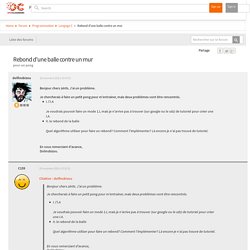

Tennis for Two. Un article de Wikipédia, l'encyclopédie libre.
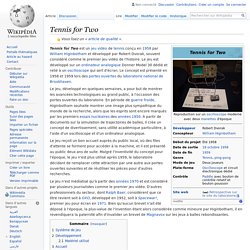
Tennis for Two est un jeu vidéo de tennis conçu en 1958 par William Higinbotham et développé par Robert Dvorak, souvent considéré comme le premier jeu vidéo de l'histoire. Le jeu est développé sur un ordinateur analogique Donner Model 30 dédié et relié à un oscilloscope qui sert d'écran. Le concept est présenté en 1958 et 1959 lors des portes ouvertes du laboratoire national de Brookhaven.
Le jeu, développé en quelques semaines, a pour but de montrer les avancées technologiques au grand public, à l'occasion des portes ouvertes du laboratoire. En période de guerre froide, Higinbotham souhaite montrer une image plus sympathique du monde de la recherche, alors que les esprits sont encore marqués par les premiers essais nucléaires des années 1950. Le jeu reçoit un bon accueil auprès du public local, où des files d'attente se forment pour accéder à la machine, et il est présenté au public deux ans de suite.
Tennis for Two. MLab in the Humanities » University of Victoria » Digging into Tennis for Two. I’ve recently been conducting research for the “Kits for Cultural History” project, focusing on an archaeology of early videogames.
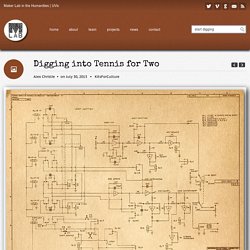
The games I’ve been examining were created before the rise of major game consoles and companies in the mid-1980s, and the graphics, sound, and gameplay mechanics of these early games are often deeply enmeshed in the technological constraints of the platform(s) on which they ran. Many of the techniques used to run these games on early arcade and home machines are being revived today by the indie game movement, although tracing a direct line from current indie games back to early videogames risks rendering game techniques purely aesthetic. As Carl Thierrien notes in Mark Wolf’s recent collection, Before the Crash: Early Video Game History: “Even with firsthand experience, one can misinterpret the actual algorithmic complexity of a game.
This raises the fundamental question of the researcher’s competence to examine historical objects” (13). Anthropy, Anna. MEGA - Museum of Electronic Games & Art. With the goal of documenting a milestone of the electronic games history and once again out of sheer joy in experimenting and spirit of research T42 (pronounced “Tea for two”) has been created, the only existing 100% analog and fully playable reconstruction of Tennis for Two by William Higinbotham from 1958.

This replica, completed May 2011 as part of the project MEGA – Museum of Electronic Games & Art, is closest to the original. Not only that it resurrects long forgotten technology, it also preserves the its charismatic relevance for both computer and video game history. Interaction Tennis for Two is a multi-player game. In this tennis simulation two players can move a light dot from one side to the other while changing the angle of the ball and its flight path. Graphics and Sounds Video screen is a 5″ analog oscilloscope.
Five relay sections produce the charismatic sounds of T42, prettifying the events serve, return, net ball and player change. Rules. Oeuvre fondatrice : Tennis for Two, le premier jeu vidéo multijoueur. Nous sommes en 14 avant Pong.
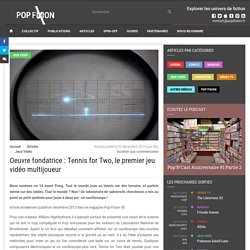
Tout le monde joue au tennis sur des terrains, et parfois même sur des tables. Tout le monde ? Non ! Tennis For Two v1.3 on Scratch. Very simple simulated video game.
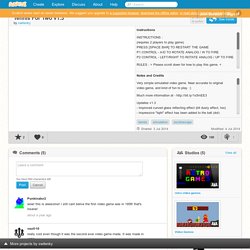
Near accurate to original video game, and kind of fun to play. :) Much more information at - Updates v1.3- Improved curved glass reflecting effect (bit dusty effect, too)- Impressive "light" effect has been added to the ball (dot)- Enhanced vector graphic virtual controllers- Tweaked physic system: NOTE - After first reset, the ball become noticeable lighter for no apparent reason at all. I will fix this small bug soon Updates v1.2- Tweaked gravity to be slightly heavier than version 1.1.- Added oscilloscope monitor glass reflection effect Bugs in v1.2 - When ball is become in contact with net, it should follow Newton's law of motion, but it doesn't. . - Sometime after resetting the game, the FIRE won't work. Tennis for two on Scratch. Tennis for Two (with sprites) on Scratch. Resurrecting Tennis for Two, a video game from 1958.
In the year 1958– fourteen years before the 1972 debut of Pong— a physicist named William Higinbotham demonstrated a remarkable video game called Tennis for Two.
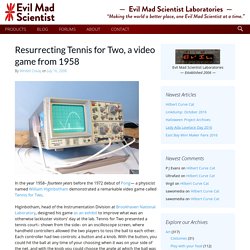
Higinbotham, head of the Instrumentation Division at Brookhaven National Laboratory, designed his game as an exhibit to improve what was an otherwise lackluster visitors’ day at the lab. Tennis for Two presented a tennis court– shown from the side– on an oscilloscope screen, where handheld controllers allowed the two players to toss the ball to each other. Each controller had two controls: a button and a knob. With the button, you could hit the ball at any time of your choosing when it was on your side of the net, and with the knob you could choose the angle at which the ball was hit. The game was based on the best contemporary technology: analog electronic computers built out of op-amps, relays, and the occasional transistor. So, the next question you might ask is, “How do you build this?”
That’s it– you should be good to go. Tennis for Two - Second video game ever made by mankind! - Discuss Scratch. In 1958, an American physicist William Higinbotham from BHL (Brookhaven National Laboratory) created a game on a Donner Model 30 analog computer, which came to known as Tennis For Two.
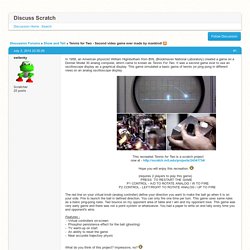
It was a second game ever to use an oscilloscope display as a graphical display. This game simulated a basic game of tennis (or ping pong in different view) on an analog oscilloscope display. This recreated Tennis for Two is a scratch project now at - Hope you will enjoy this recreation. (requires 2 players to play this game) PRESS TO RESTART THE GAME P1 CONTROL - A/D TO ROTATE ANALOG / W TO FIRE P2 CONTROL - LEFT/RIGHT TO ROTATE ANALOG / UP TO FIRE The red line on your virtual knob (analog controller) define your direction you want to make the ball go when it is on your side. Gamedesignerben: Conserving Tennis For Two. Netpong – Table Tennis for Two – ZedBit – The Last Bit.
Netpong honors one the very first computer games, Table Tennis for Two, and the later Atari implementation of Pong.
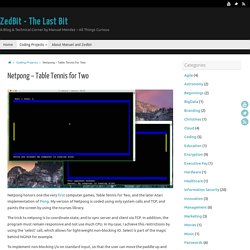
My version of Netpong is coded using only system calls and TCP, and paints the screen by using the ncurses library. The trick to netpong is to coordinate state, and to sync server and client via TCP. In addition, the program must remain responsive and not use much CPU. In my case, I achieve this restrictions by using the ‘select’ call, which allows for light-weight non-blocking IO. Select is part of the magic behind NGINX for example.
To implement non-blocking i/o on standard input, so that the user can move the paddle up and down, or quit if desired, I use select() to block/sleep, and to watch for the socket and standard input. When playing, both the server and client use select() to attend to keyboard input (to move the paddle, or to quit)I also use select() to read when data is ready. Tennis For Two Simulator. SpindleyQ / TennisForTwo. L'animation procédurale. Introduction à la simulation - Chute d'un corps. File failed to load: Introduction La simulation est un outil puissant pour étudier et comprendre les phénomènes physiques.
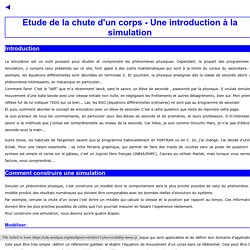
Cependant, la plupart des programmes de simulation, y compris ceux présentés sur ce site, font appel à des outils mathématiques qui sont à la limite du cursus du secondaire. Par exemple, les équations différentielles sont abordées en terminale S. Et pourtant, la physique enseignée dès la classe de seconde décrit des phénomènes intéressants, en mécanique en particulier... Autre chose, les habitués de TangenteX savent que je programme habituellement en FORTRAN ou en C. Bouncing Ball Algorithm. Openclassrooms. Modélisation de rebond d'une balle.
Rebond d'une balle contre un mur - pour un pong by dolfinsbizou. Citation : Pouet_forever Faut arrêter la touchette, pour un pong ya pas à ce faire chier avec la physique ou autre...
